-
Most new users don't bother reading our rules. Here's the one that is ignored almost immediately upon signup: DO NOT ASK FOR FANEDIT LINKS PUBLICLY. First, read the FAQ. Seriously. What you want is there. You can also send a message to the editor. If that doesn't work THEN post in the Trade & Request forum. Anywhere else and it will be deleted and an infraction will be issued.
-
Please read our Rules & Guidelines
Read BEFORE posting Trades & Request
You are using an out of date browser. It may not display this or other websites correctly.
You should upgrade or use an alternative browser.
You should upgrade or use an alternative browser.
experimenting with the AI, trying to break it as a technique for meta commentary
- Thread starter tremault
- Start date
- Messages
- 1,214
- Reaction score
- 1,383
- Trophy Points
- 123
hmm... yeah. I guess it was more of a dumb stunt than I thought. I'm not even sure what exactly I was trying to say.I don't think I see the point.
I have to be honest, I initially planned to use one of my poems as the input prompt, as I had some thoughts about how we are data and our existence is like poetry, but then bing create wasn't working so I thought I wanted to post an image so I thought maybe it'd be edgy to post a non AI image and it had to be relevant somehow, right? But I didn't think it through properly and I'm a little embarrassed ^^;
- Messages
- 1,214
- Reaction score
- 1,383
- Trophy Points
- 123
Hopefully I can recover from that ^^
Since I found DreamStudio and that is working, the original reason I visited this topic earlier on today, I was thinking about how each of us, our personality and thoughts, is like music being played within the composition of the universe. We are data and our stories define who we are, and therefore I felt I'd put some of my poetry into the AI and consider the mage. How much of the image is a manifestation of who I am? I think it's well established that it wouldn't be my art, but it still comes from me, through the filter of millions of artists?
prompt:
Twilight of the year,
Footsteps through leaves,
Nature is retiring,
Birds vacate eaves.
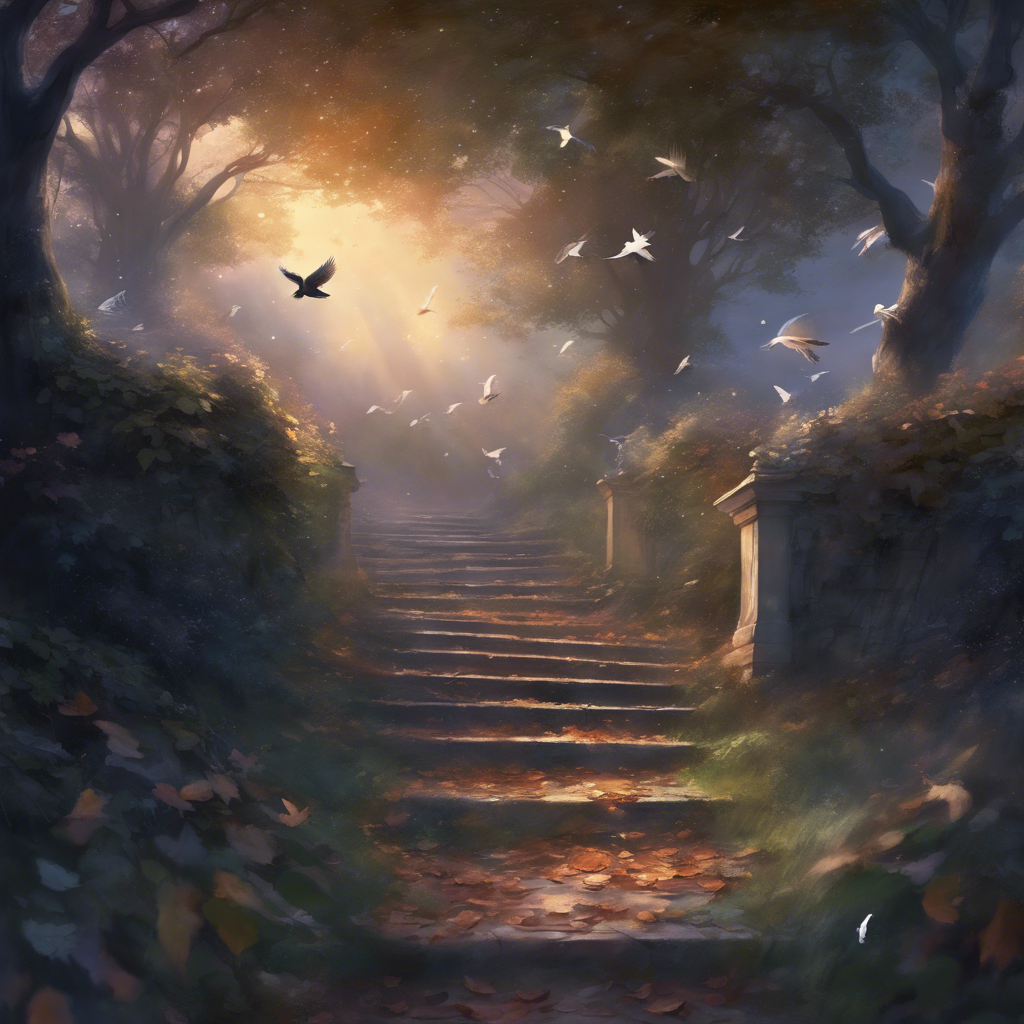
Since I found DreamStudio and that is working, the original reason I visited this topic earlier on today, I was thinking about how each of us, our personality and thoughts, is like music being played within the composition of the universe. We are data and our stories define who we are, and therefore I felt I'd put some of my poetry into the AI and consider the mage. How much of the image is a manifestation of who I am? I think it's well established that it wouldn't be my art, but it still comes from me, through the filter of millions of artists?
prompt:
Twilight of the year,
Footsteps through leaves,
Nature is retiring,
Birds vacate eaves.

Last edited:
- Messages
- 8,747
- Reaction score
- 3,648
- Trophy Points
- 168
This is basically the majority of Disney animation. I'd definitely consider that to be art.That's a tough one because a lot of artists work by copying what they see or have seen. (as opposed to some artists who construct drawing based on anatomical knowledge, etc).
- Messages
- 274
- Reaction score
- 369
- Trophy Points
- 83
Again, no.I was pretty descriptive, Is this my art or not?
You're the client in this situation, not the artist.
Doesn't matter how descriptive a client is about what they want, when I turn over my artwork, it's something I made, not them.
They can own the piece, making it theirs in that way, but they'll never be able to say that they made it.
Edit- ok, yeah. that was a dumb stunt, but my point about ai still stands.
Last edited:
- Messages
- 1,214
- Reaction score
- 1,383
- Trophy Points
- 123
Sorry, that post isn't what I originally intended and I got twisted up in my head, it is actually my art. I don't know what I was thinking or trying to achieve.Again, no.
You're the client in this situation, not the artist.
Doesn't matter how descriptive a client is about what they want, when I turn over my artwork, it's something I made, not them.
They can own the piece, making it theirs in that way, but they'll never be able to say that they made it.
I just edited the post to clarify that it's not to be taken seriously.
- Messages
- 1,214
- Reaction score
- 1,383
- Trophy Points
- 123
I'm thinking about where my head was at yesterday. I think that post was in support of what others have been saying, is something considered art because of where it came from or because of what a person perceives when they look at it. Linking it back to the sunset example, some may consider the sunset to be art, because it presents something beautiful.
the image I posted needn't be made by ai or by me for people to receive it and make an observation on it. For that concept to be understood, it had to be ambiguous by nature or nothing would have been learned. What I personally learned was that @addiesin and @unfair are saying some very salient things and I need to take note.
the image I posted needn't be made by ai or by me for people to receive it and make an observation on it. For that concept to be understood, it had to be ambiguous by nature or nothing would have been learned. What I personally learned was that @addiesin and @unfair are saying some very salient things and I need to take note.
- Messages
- 398
- Reaction score
- 557
- Trophy Points
- 113
With all this talk about what is or isn't art, I thought it would be interesting to ask the AI what it thinks art is.
So I did a bunch of generations with the prompt art with no other context, and the results were pretty interesting.
The majority of the generated images can be sorted into three main categories:
These two are similar to the "Gallery" and "Workshop" categories, but focus on a single subject.
Whereas the other categories represent the creation and display of "art" as a public or community affair, these images seem a lot more personal, and could be a single person's work or collection.
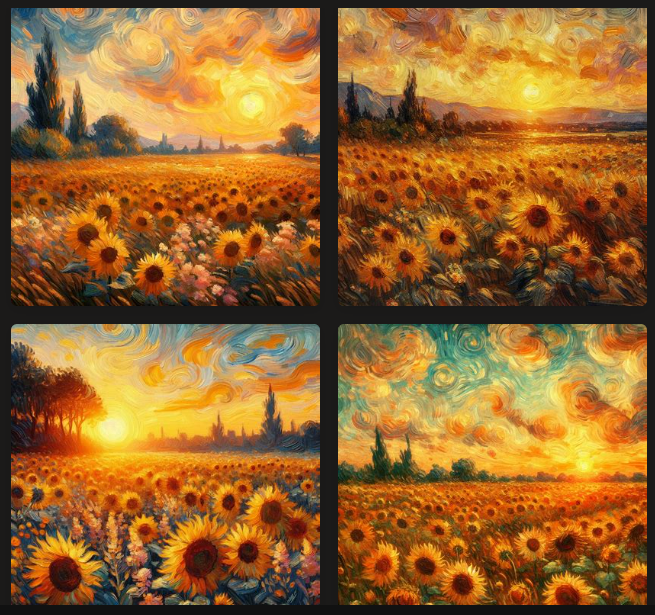
These images are clearly based on the works of Vincent Van Gough. I don't think I need to elaborate much, since Van Gogh is one of the most famous painters in history that would certainly come to most people's mind pretty quickly when asked about "art".
What is interesting is that Van Gogh never actually painted a sunset or sunrise that looked like this, and I couldn't find another artist imitating him that did this either, which means that the AI could be successfully adapting Van Gogh's signature style to create something new that fits the style.
Very cool!
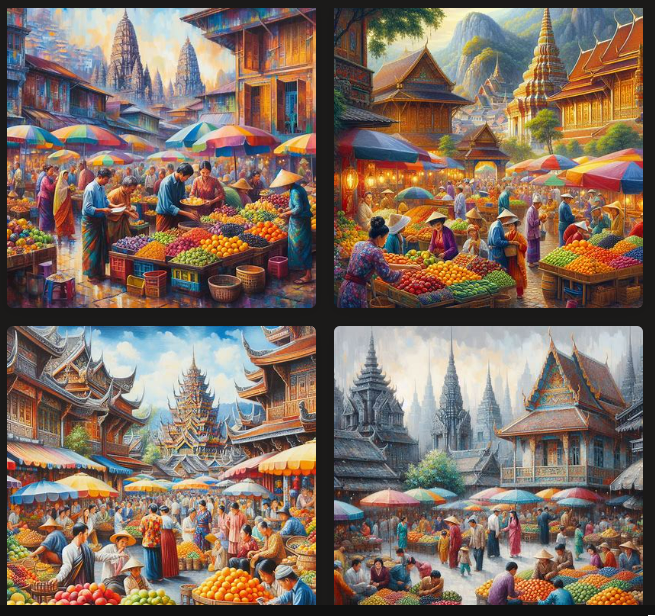
This one is super weird, but the AI seems to have specifically created images of a Cambodian or Laotian market place in this generation, and I can't imagine why.
Was there a famous artist known for paintings of Asian markets?
I would be interested to hear people's theories on this one.
It would also be cool to see what other people get using the prompt art to see what they get. One of the "patterns" images has what looks a little like a bow and arrow in it, so it's possible that the AI was influenced in some way by previous prompts and generations I had done. Or maybe even influenced by cookies and search history
So I did a bunch of generations with the prompt art with no other context, and the results were pretty interesting.
The majority of the generated images can be sorted into three main categories:
Patterns:
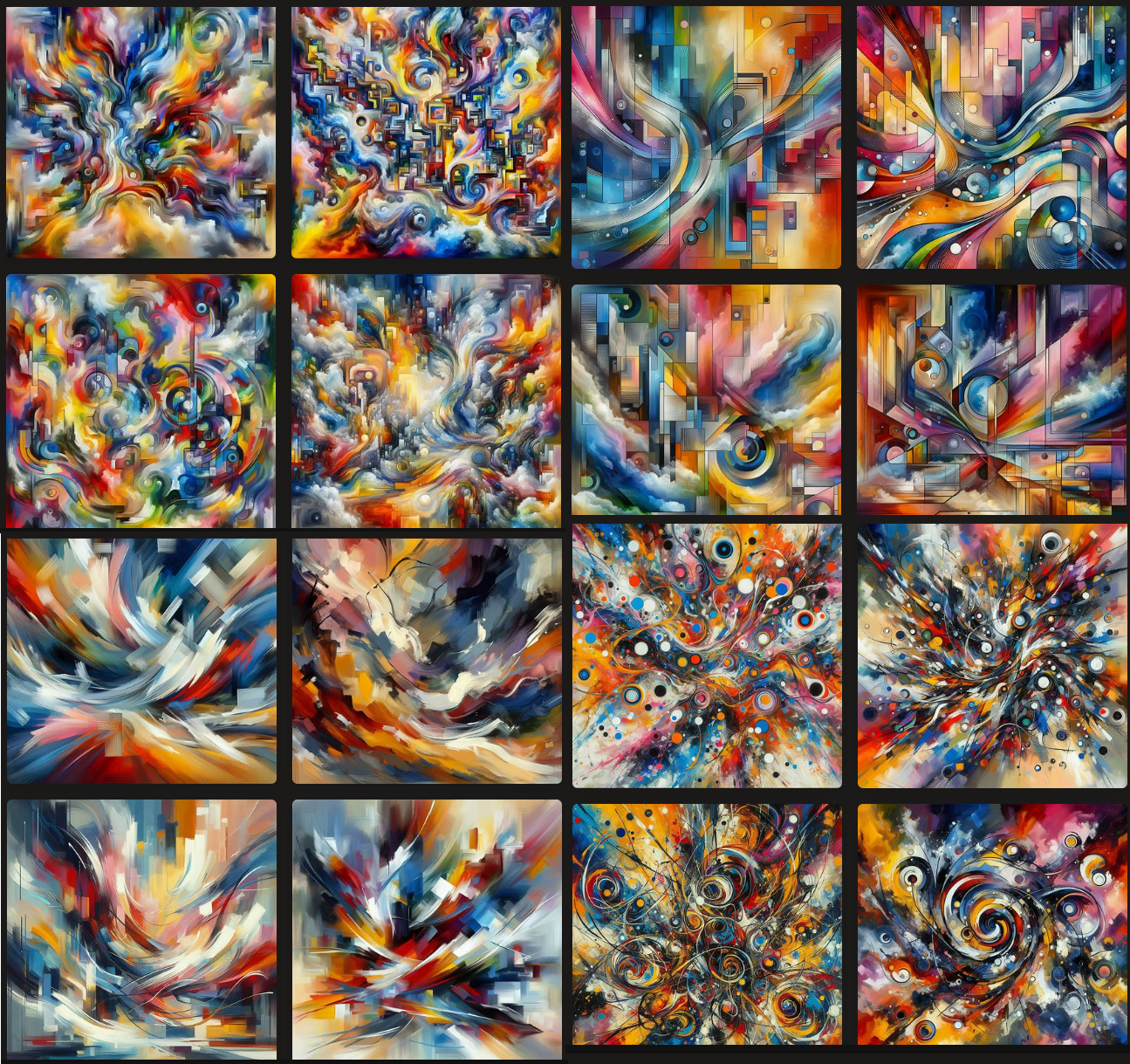
These images seem to represent what the algorithm identifies as the common contents of images identified as "art".
They're all entirely abstract with swirling colours that don't seem to represent anything in particular but mostly resemble physical paint. you can see brush strokes in them, and the images in the bottom-right resemble the signature paint splashing that has come to represent "modern art" along the lines of Jackson Pollack.
The images on the top right, however, don't resemble paint and seem to be based on digital art they are also the least abstract and seem to contain actual objects like clouds, bubbles and even the moon.
What's super interesting to me are the straight lines and geometric patterns visible in some of the images.
I think this is the AI's attempt to integrate more structured elements of landscapes and cityscapes into the abstract style.
I'm not familiar with a lot of art, but I don't think I've seen anything that completely resembles the images generated here. I think this could actually be seen as an "AI Style"
Galleries:
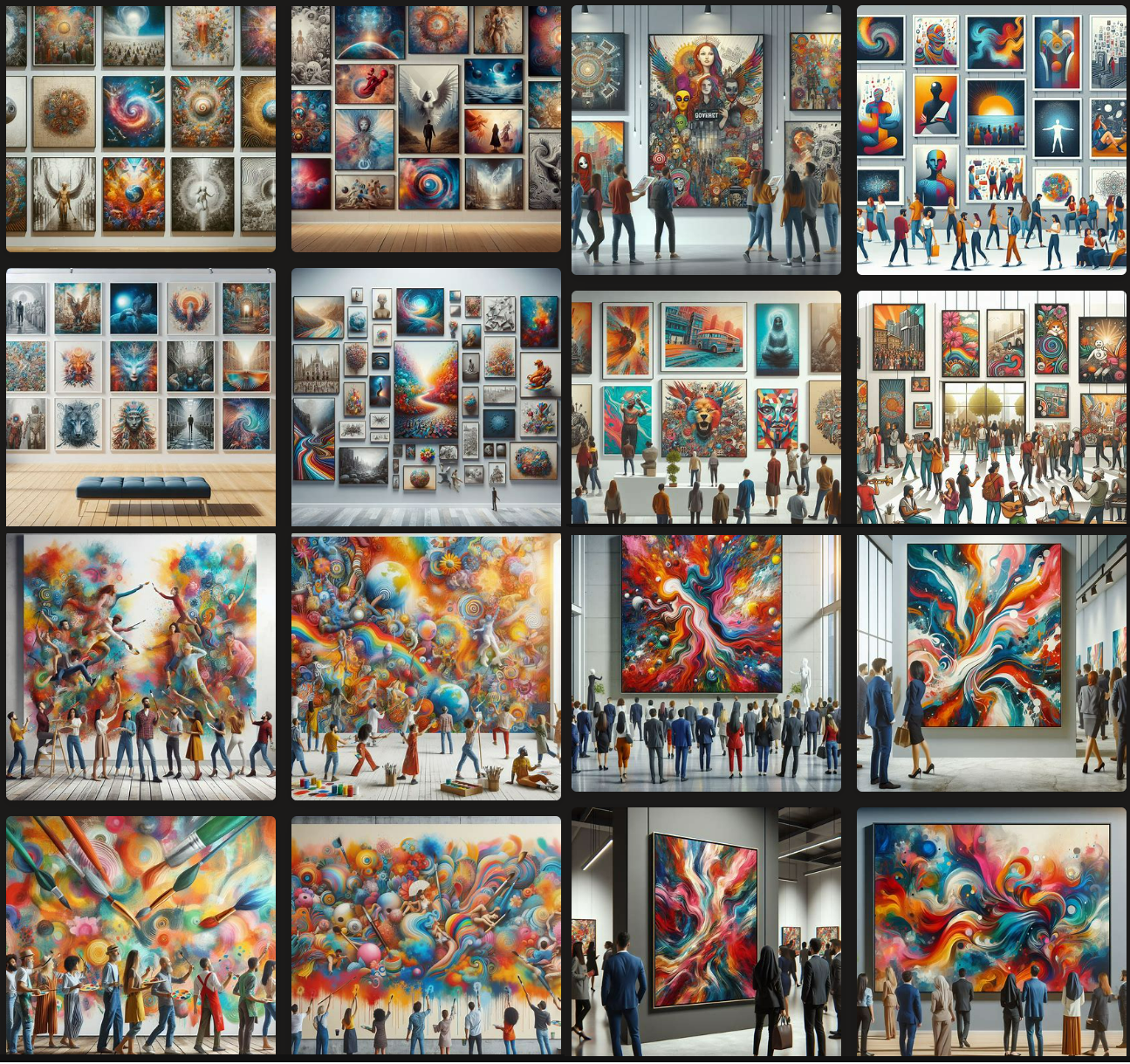
These images all represent "art" as being displayed in galleries for public viewing.
(I just realised that the four in the bottom-left actually depict a painting in progress. I'll mention that later)
It's easy to understand the idea of art being intrinsically connected to art galleries, but I think there is something in the idea that "art" is partially defined in pop-culture as being something that is displayed.
The content of the "art" is also interesting. The bottom-right images resemble the patterns in the previous category, but the other images all contain elements that represent real things, although they all have some degree of abstraction, with the possible exception of one piece which looks like that 19th century pen illustration style, which at that time was intended to be as literal as possible, but today is definitely used a stylistic choice.
It's possible that these images were generated based on real images of art galleries that the AI was trained on, with the exception of the images in the bottom-left, which appear to be an accidental fusion of the art gallery category with the next category, and I don't think are based directly on real images.
Workshops:
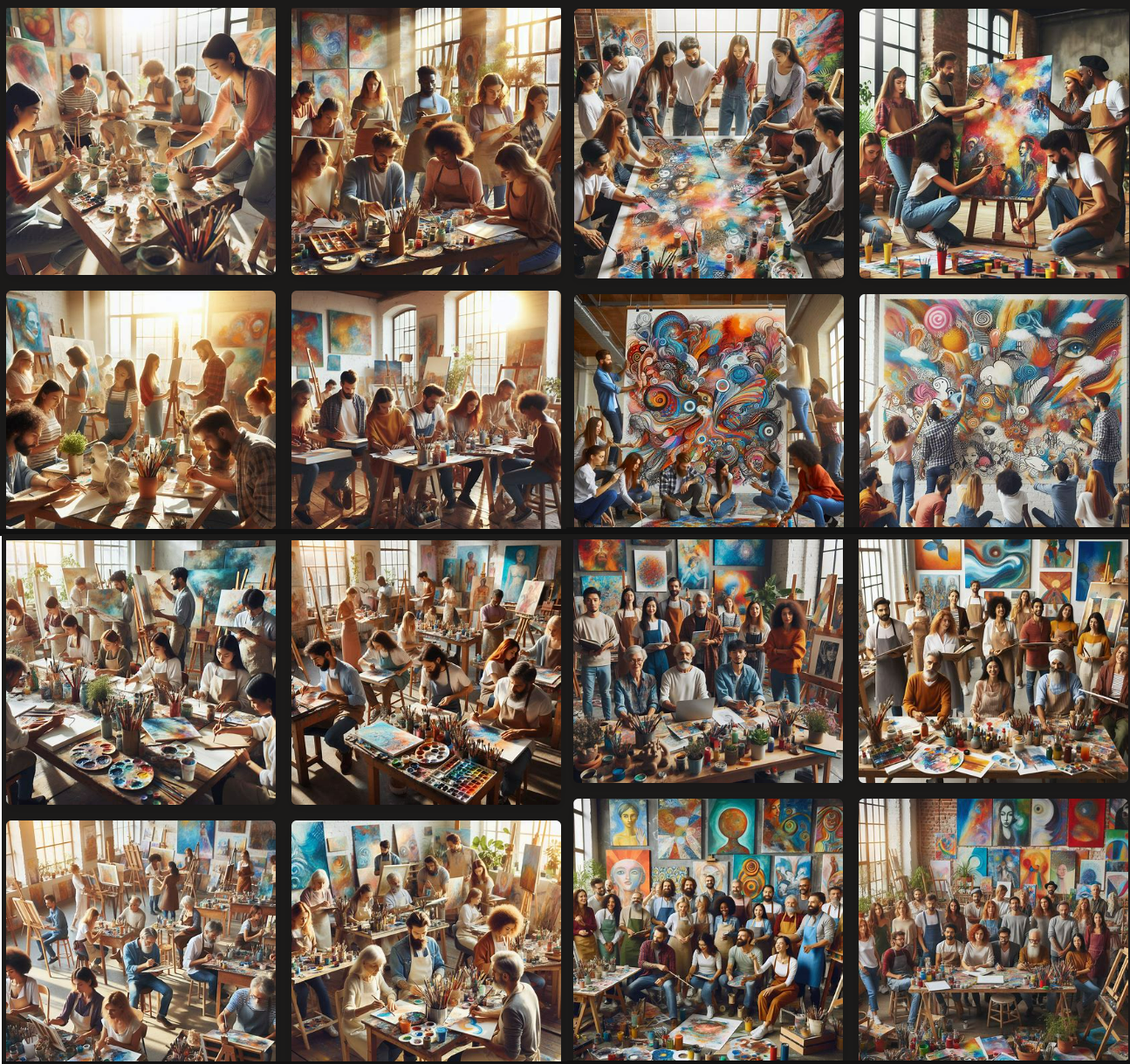
These images all represent "art" being created by many people in an art workshop. The content of the art itself is very similar to the previous two categories.
There's not much to say from this one except that they all conflate "art" with painting which is understandable, since that's probably the first medium that comes to someone's mind when they think of "art".
Another interesting fact is that the image in the top-left is the first time I've seen an image generator create two identical people in one image, and then it did it again two images down (in a separate round of generations).
I think the most likely reason for this is that these images are all from stock photos and those women are based on actual twin models that are in many of the photos. It would be interesting to see if I could find those images and prove that theory right.
That actually brings me on to a potential problem with these experiments:
It's possible that this AI was trained exclusively on stock images in order to minimise the legal awkwardness around how using images for AI training could be restricted by copyright. This would mean we're not getting a true representation of how people in general view these concepts, but rather a filtered version through a "safe", "mass-appeal" type lens, and the way stock images represent their subjects is intentional rather than incidental, which means they are sort-of contaminated by the director's perspective.
This may also explain some-of the swirly cloud-like images chosen to represent the "art" itself. I seem to remember an abundance of colourful powder, space and nebula themed stock images made throughout the 2010s to serve as desktop backgrounds, websites, and such.
Unique Generations
There were three groups of images generated by the "art" prompt that were quite different from the one's described above:
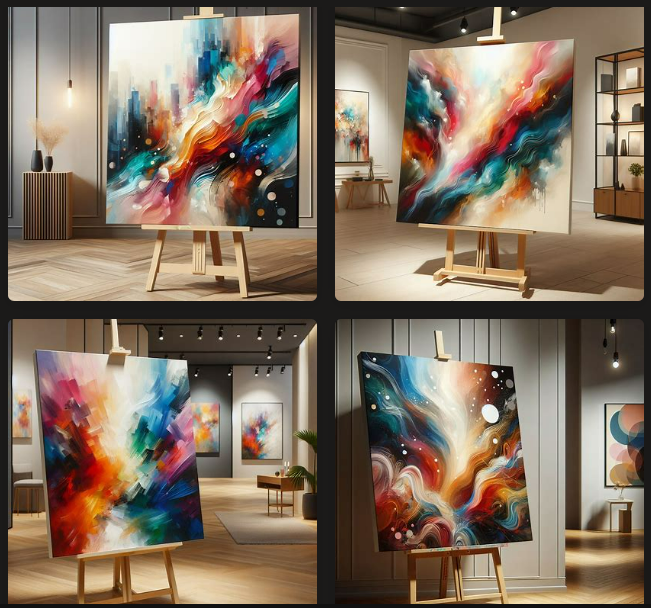


These images seem to represent what the algorithm identifies as the common contents of images identified as "art".
They're all entirely abstract with swirling colours that don't seem to represent anything in particular but mostly resemble physical paint. you can see brush strokes in them, and the images in the bottom-right resemble the signature paint splashing that has come to represent "modern art" along the lines of Jackson Pollack.
The images on the top right, however, don't resemble paint and seem to be based on digital art they are also the least abstract and seem to contain actual objects like clouds, bubbles and even the moon.
What's super interesting to me are the straight lines and geometric patterns visible in some of the images.
I think this is the AI's attempt to integrate more structured elements of landscapes and cityscapes into the abstract style.
I'm not familiar with a lot of art, but I don't think I've seen anything that completely resembles the images generated here. I think this could actually be seen as an "AI Style"
Galleries:

These images all represent "art" as being displayed in galleries for public viewing.
(I just realised that the four in the bottom-left actually depict a painting in progress. I'll mention that later)
It's easy to understand the idea of art being intrinsically connected to art galleries, but I think there is something in the idea that "art" is partially defined in pop-culture as being something that is displayed.
The content of the "art" is also interesting. The bottom-right images resemble the patterns in the previous category, but the other images all contain elements that represent real things, although they all have some degree of abstraction, with the possible exception of one piece which looks like that 19th century pen illustration style, which at that time was intended to be as literal as possible, but today is definitely used a stylistic choice.
It's possible that these images were generated based on real images of art galleries that the AI was trained on, with the exception of the images in the bottom-left, which appear to be an accidental fusion of the art gallery category with the next category, and I don't think are based directly on real images.
Workshops:

These images all represent "art" being created by many people in an art workshop. The content of the art itself is very similar to the previous two categories.
There's not much to say from this one except that they all conflate "art" with painting which is understandable, since that's probably the first medium that comes to someone's mind when they think of "art".
Another interesting fact is that the image in the top-left is the first time I've seen an image generator create two identical people in one image, and then it did it again two images down (in a separate round of generations).
I think the most likely reason for this is that these images are all from stock photos and those women are based on actual twin models that are in many of the photos. It would be interesting to see if I could find those images and prove that theory right.
That actually brings me on to a potential problem with these experiments:
It's possible that this AI was trained exclusively on stock images in order to minimise the legal awkwardness around how using images for AI training could be restricted by copyright. This would mean we're not getting a true representation of how people in general view these concepts, but rather a filtered version through a "safe", "mass-appeal" type lens, and the way stock images represent their subjects is intentional rather than incidental, which means they are sort-of contaminated by the director's perspective.
This may also explain some-of the swirly cloud-like images chosen to represent the "art" itself. I seem to remember an abundance of colourful powder, space and nebula themed stock images made throughout the 2010s to serve as desktop backgrounds, websites, and such.
Unique Generations
There were three groups of images generated by the "art" prompt that were quite different from the one's described above:


These two are similar to the "Gallery" and "Workshop" categories, but focus on a single subject.
Whereas the other categories represent the creation and display of "art" as a public or community affair, these images seem a lot more personal, and could be a single person's work or collection.

These images are clearly based on the works of Vincent Van Gough. I don't think I need to elaborate much, since Van Gogh is one of the most famous painters in history that would certainly come to most people's mind pretty quickly when asked about "art".
What is interesting is that Van Gogh never actually painted a sunset or sunrise that looked like this, and I couldn't find another artist imitating him that did this either, which means that the AI could be successfully adapting Van Gogh's signature style to create something new that fits the style.
Very cool!

This one is super weird, but the AI seems to have specifically created images of a Cambodian or Laotian market place in this generation, and I can't imagine why.
Was there a famous artist known for paintings of Asian markets?
I would be interested to hear people's theories on this one.
Those are all the images I generated. I'm not sure how valuable this analysis is to anyone, but if you have any thoughts let me know!It would also be cool to see what other people get using the prompt art to see what they get. One of the "patterns" images has what looks a little like a bow and arrow in it, so it's possible that the AI was influenced in some way by previous prompts and generations I had done. Or maybe even influenced by cookies and search history
Last edited:
- Messages
- 224
- Reaction score
- 212
- Trophy Points
- 53
What is interesting is that Van Gogh never actually painted a sunset or sunrise that looked like this, and I couldn't find another artist imitating him that did this either, which means that the AI could be successfully adapting Van Gogh's signature style to create something new that fits the style.
I believe it's the AI doing a daylight mashup of his Starry Night painting and his Sunflowers painting, two of his most famous. Although it's clearly taking an interesting logical path because it isn't actually using his painting of the sunflowers, it's taken the word as a reference, found the pattern for a field of sunflowers - likely from seeing a bunch of pictures and then rendered that image in van gogh's style. Neat little look into how AI "thinks", using a synthesis of keywords and style.
- Messages
- 398
- Reaction score
- 557
- Trophy Points
- 113
What I find really cool about those images is the way the sun is depicted with all that glare, and reflections coming off the objects. Van Gogh never painted light that way. His style generally used pretty flat colours.
And although the swirly sky is clearly taken from Starry Night, or Wheat Field with Cypresses (which is also where it gets the trees from), if you compare them, the swirls are actually done very differently.
And yet, the textures and brush strokes are very close to Van Gogh (in some images more than others). The elements that don't come from Van Gogh are seamlessly integrated with the elements that do.
The resulting image immediately and obviously evokes Van Gogh, but it has aspects to it that make it distinct from anything he actually painted.
And it's doing all of this just from the prompt "art". It's as if it looked up "art", found sunset landscapes and Sunflowers by Van Gogh, Looked up "Sunflowers" and "Van Gogh", found sunflower fields and Van Gogh's other paintings, and tried to put together everything it had learned into something that really is new.
This is all speculation on what's happening inside the black box, but it implies a level of sophistication that I didn't know image generators were capable of, and it's cemented my belief that (this one at least) doesn't "copy" the images that are fed to it, because even when it is copying, it's not really copying.
And although the swirly sky is clearly taken from Starry Night, or Wheat Field with Cypresses (which is also where it gets the trees from), if you compare them, the swirls are actually done very differently.
And yet, the textures and brush strokes are very close to Van Gogh (in some images more than others). The elements that don't come from Van Gogh are seamlessly integrated with the elements that do.
The resulting image immediately and obviously evokes Van Gogh, but it has aspects to it that make it distinct from anything he actually painted.
And it's doing all of this just from the prompt "art". It's as if it looked up "art", found sunset landscapes and Sunflowers by Van Gogh, Looked up "Sunflowers" and "Van Gogh", found sunflower fields and Van Gogh's other paintings, and tried to put together everything it had learned into something that really is new.
This is all speculation on what's happening inside the black box, but it implies a level of sophistication that I didn't know image generators were capable of, and it's cemented my belief that (this one at least) doesn't "copy" the images that are fed to it, because even when it is copying, it's not really copying.
- Messages
- 398
- Reaction score
- 557
- Trophy Points
- 113
Out of curiosity, I did a couple of generations with the prompt "nghệ thuật", which is "art" in Vietnamese, to see whether the result from a prompt is affected by the culture of the prompt's language.
The results were pretty much the same. I got a Dali, two galleries and the exact same black grandpa painting that I got from the English prompt.
This tells me that either the AI can translate it's prompts to search in all languages or (more likely imo) the stock images that the AI was trained on had their labels translated into all sorts of languages in order to sell them in all sorts of markets.
I did get some interesting info from the Dali inspired generation, though:
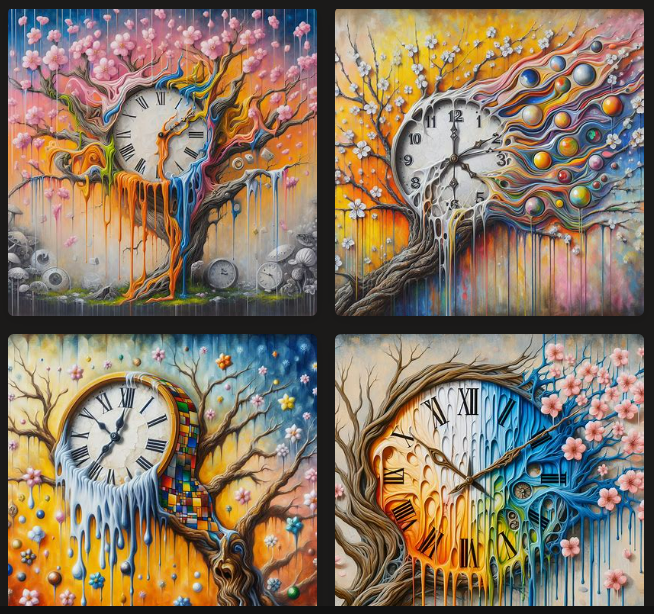
Clearly, the AI got the message that Dali melted clocks, but it didn't actually copy his clock melting paintings. Instead, it came up with it's own idea of what a melting clock looked like. And, although one of the clocks was hanging from a small tree branch in Dali's famous painting, it's nothing like the cherry blossom that the AI chose for these pictures.
I can only imagine that this means that the AI is drawing just as much from text sources as it is from images!
This is a crazy revelation to me, and it might be the secret to why DALL-E (lol) is so much better than other image generator's that are available.
It does make me wonder whether it's doing its "thinking" or "searching" in the language of the prompt, or if it can search in all languages that it has a lexicon for.
The cherry blossom isn't particularly relevant to Vietnam, but it could be that the sources describing "nghệ thuật" draw from Japanese or Korean art history.
Also, I think the different coloured and sized squares in one of the images are from another 20th century artist as well, but I cant remember who.
Edit:
Prompting with "Dali" Proves it.
The AI isn't generating images based on Dali's paintings. It's looking at a description of Dali, and creating an image based on that.
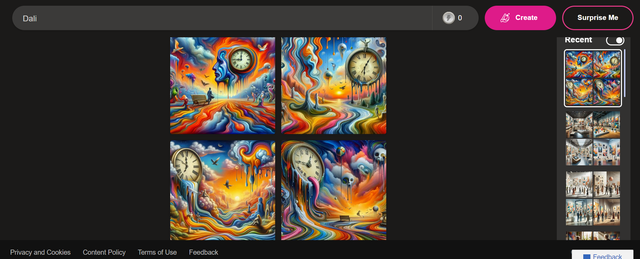
We're getting into heavy speculation here, but this may be the developer's way of avoiding plagiarism, or the accusation of plagiarism. The AI is trained on images of individual things or concepts, and combines them based on what descriptions it can find based on the prompt.
Or it might be a way for the AI do try to create images of things it hasn't seen before. If Dali's paintings aren't available to it, it falls back on a text source.
It's impossible to know for sure, but whatever it is, it's cool as hell!
The results were pretty much the same. I got a Dali, two galleries and the exact same black grandpa painting that I got from the English prompt.
This tells me that either the AI can translate it's prompts to search in all languages or (more likely imo) the stock images that the AI was trained on had their labels translated into all sorts of languages in order to sell them in all sorts of markets.
I did get some interesting info from the Dali inspired generation, though:

I can only imagine that this means that the AI is drawing just as much from text sources as it is from images!
This is a crazy revelation to me, and it might be the secret to why DALL-E (lol) is so much better than other image generator's that are available.
It does make me wonder whether it's doing its "thinking" or "searching" in the language of the prompt, or if it can search in all languages that it has a lexicon for.
The cherry blossom isn't particularly relevant to Vietnam, but it could be that the sources describing "nghệ thuật" draw from Japanese or Korean art history.
Also, I think the different coloured and sized squares in one of the images are from another 20th century artist as well, but I cant remember who.
Edit:
Prompting with "Dali" Proves it.
The AI isn't generating images based on Dali's paintings. It's looking at a description of Dali, and creating an image based on that.

Or it might be a way for the AI do try to create images of things it hasn't seen before. If Dali's paintings aren't available to it, it falls back on a text source.
It's impossible to know for sure, but whatever it is, it's cool as hell!
Last edited:
- Messages
- 1,214
- Reaction score
- 1,383
- Trophy Points
- 123
I think it's more likely that art in Vietnam is also associated with clocks and trees. I don't know anything about Vietnam so I couldn't begin to guess if there is a cultural link there.
From what I understand of the AI, it's not thinking, it's not capable of reasoning, so what we have been presented is what image patterns are usually associated with this words.
Here's a couple of tests with Bing Create.
This is images for Tattoo in English
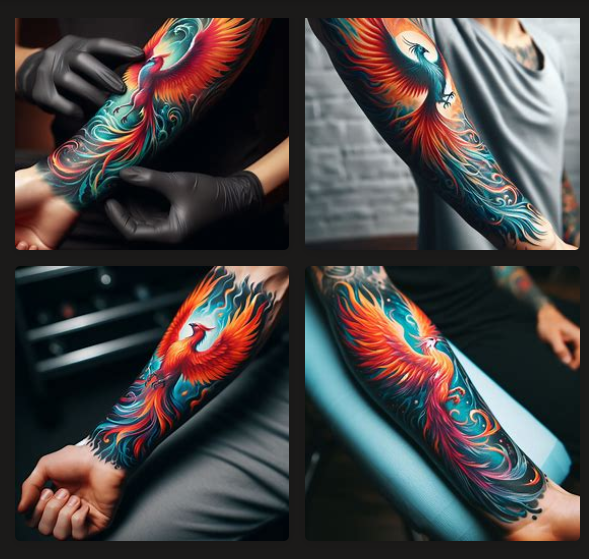
and 刺青 in Japanese, which we might expect to be associated with crime.
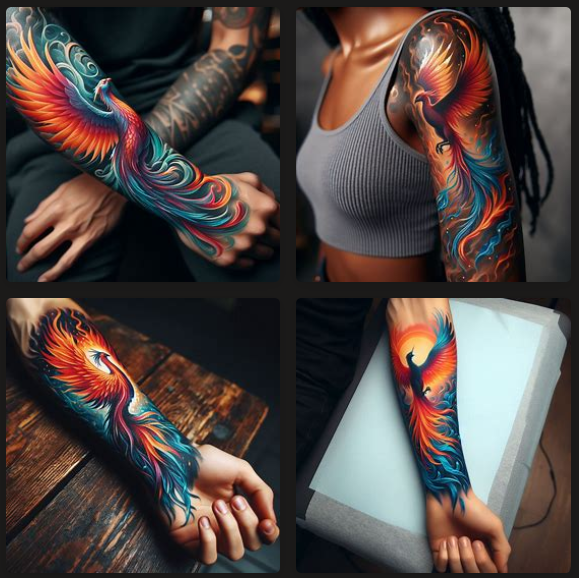
So it seems Bing doesn't distinguish between languages.
unless, the words can be interchangeable in other languages?
From what I understand of the AI, it's not thinking, it's not capable of reasoning, so what we have been presented is what image patterns are usually associated with this words.
Here's a couple of tests with Bing Create.
This is images for Tattoo in English

and 刺青 in Japanese, which we might expect to be associated with crime.

So it seems Bing doesn't distinguish between languages.
unless, the words can be interchangeable in other languages?
- Messages
- 694
- Reaction score
- 1,038
- Trophy Points
- 118
The Britannica definition of art:
“something that is created with imagination and skill and that is beautiful or that expresses important ideas or feelings”
Are some of the AI images in this thread beautiful? Yes. And since beauty is subjective the answer is always yes.
Does AI possess imagination and skill? Maybe. But for the sake of argument let’s say it does not.
Soon we will reach the point where it will be impossible to tell the difference between human art and AI art (for some art styles we’ve already reached that point).
And when it is no longer possible to tell the difference everything is art or nothing is art.
“something that is created with imagination and skill and that is beautiful or that expresses important ideas or feelings”
Are some of the AI images in this thread beautiful? Yes. And since beauty is subjective the answer is always yes.
Does AI possess imagination and skill? Maybe. But for the sake of argument let’s say it does not.
Soon we will reach the point where it will be impossible to tell the difference between human art and AI art (for some art styles we’ve already reached that point).
And when it is no longer possible to tell the difference everything is art or nothing is art.
VarsityEditor
Well-known member
- Messages
- 117
- Reaction score
- 143
- Trophy Points
- 48
Given the context, these are interesting names you chose to make your point (rather than saying Van Gogh/Picasso/etc), as artists like Hirst and Banksy largely don't make their own work, but have teams of assistants who create the works upon direction from the artist. (I think the same is probably true of Warhol but I'm not totally sure.) Certainly, Banksy has a team who execute his designs, but Hirst is the best example – he himself didn't put a shark into a vat of formaldehyde, and didn't even do his own spot paintings. He has ideas and hires skilled professionals to make them.[...] Gaudi wasn't an artist, he was an architect. Certainly, architecture can have artistic flair in a big way, but there is an exclusive definition of 'art' that describes the types of works that serve a singular purpose, by people like Damien Hirst, Andy Warhol, Banksy, etc. these works serve one purpose and that is to make the receiver think in different ways about society, It doesn't serve any other purpose, such as shelter from weather, or advertising a product, or telling a story, or as a backdrop for dance, etc.
- Messages
- 1,214
- Reaction score
- 1,383
- Trophy Points
- 123
This is an area I need to learn more about. My experience with art is not really within the mainstream art world. I tend to skit around the periphery with an interest in more esoteric ideas. I don't have a lot of knowledge of the classics and I'm not completely familiar with working methodologies of specific artists. Perhaps that means I'm not well qualified to comment on this subject? I'm not sure. I only hope that the ideas I have can be conveyed and that I can understand what you guys are saying well enough.Given the context, these are interesting names you chose to make your point (rather than saying Van Gogh/Picasso/etc), as artists like Hirst and Banksy largely don't make their own work, but have teams of assistants who create the works upon direction from the artist. (I think the same is probably true of Warhol but I'm not totally sure.) Certainly, Banksy has a team who execute his designs, but Hirst is the best example – he himself didn't put a shark into a vat of formaldehyde, and didn't even do his own spot paintings. He has ideas and hires skilled professionals to make them.
Moe_Syzlak
Well-known member
- Messages
- 3,495
- Reaction score
- 1,214
- Trophy Points
- 118
- Messages
- 224
- Reaction score
- 212
- Trophy Points
- 53
Someone should tell her we solved those time consuming tasks back in the mid-to-late 1800's with non-AI machines. The only way it could get any easier is if a robot loaded the machines for her, saving her dozens of minutes per week.
- Messages
- 398
- Reaction score
- 557
- Trophy Points
- 113
That's not real laundry, though. If you don't use a washboard it doesn't count.Someone should tell her we solved those time consuming tasks back in the mid-to-late 1800's with non-AI machines. The only way it could get any easier is if a robot loaded the machines for her, saving her dozens of minutes per week.
Duragizer
Well-known member
- Messages
- 2,397
- Reaction score
- 66
- Trophy Points
- 63
I experimented with taking some of my old collages/drawings and running them through an AI generator to see what results I got. Here's an example:
The original collage:
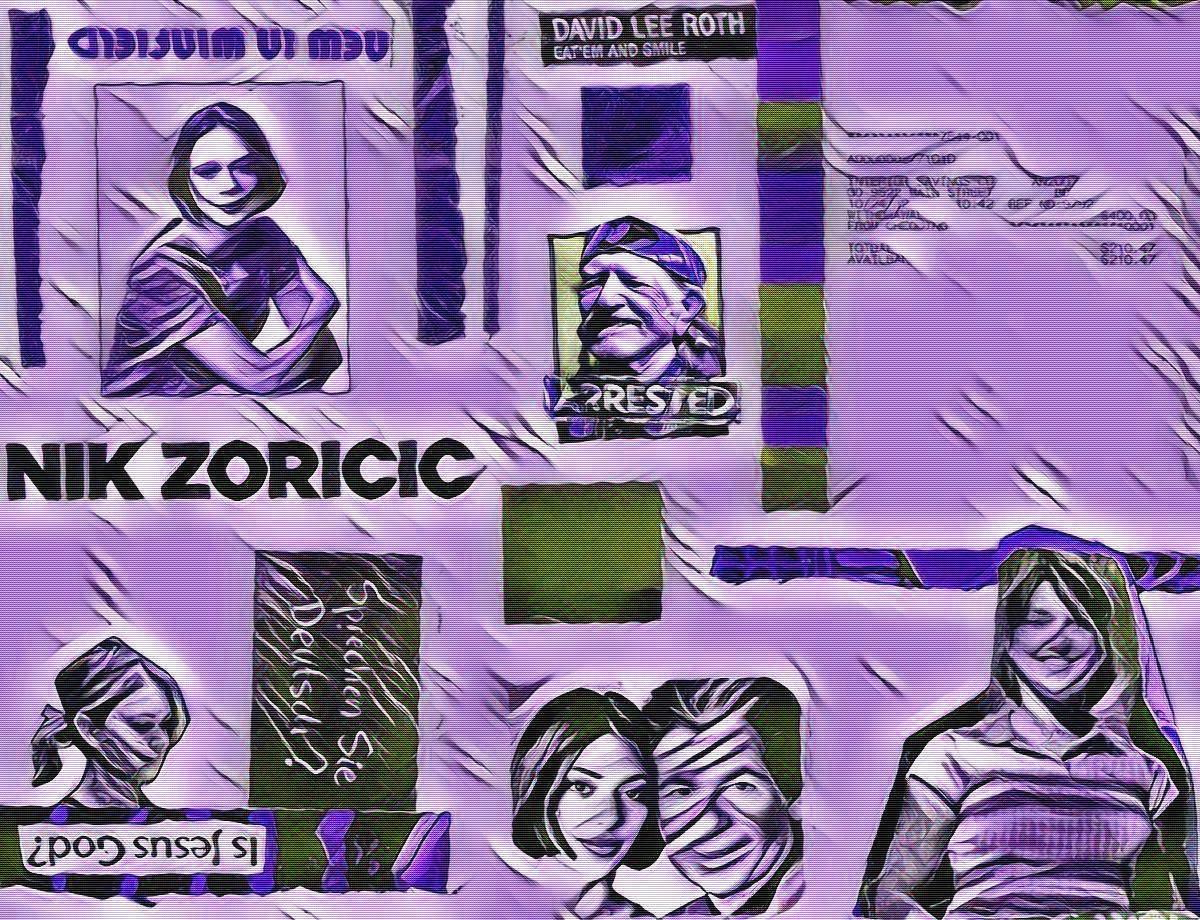
And ten AI triptychs I cobbled together, using the collage's title — Platitudes — as the prompt:

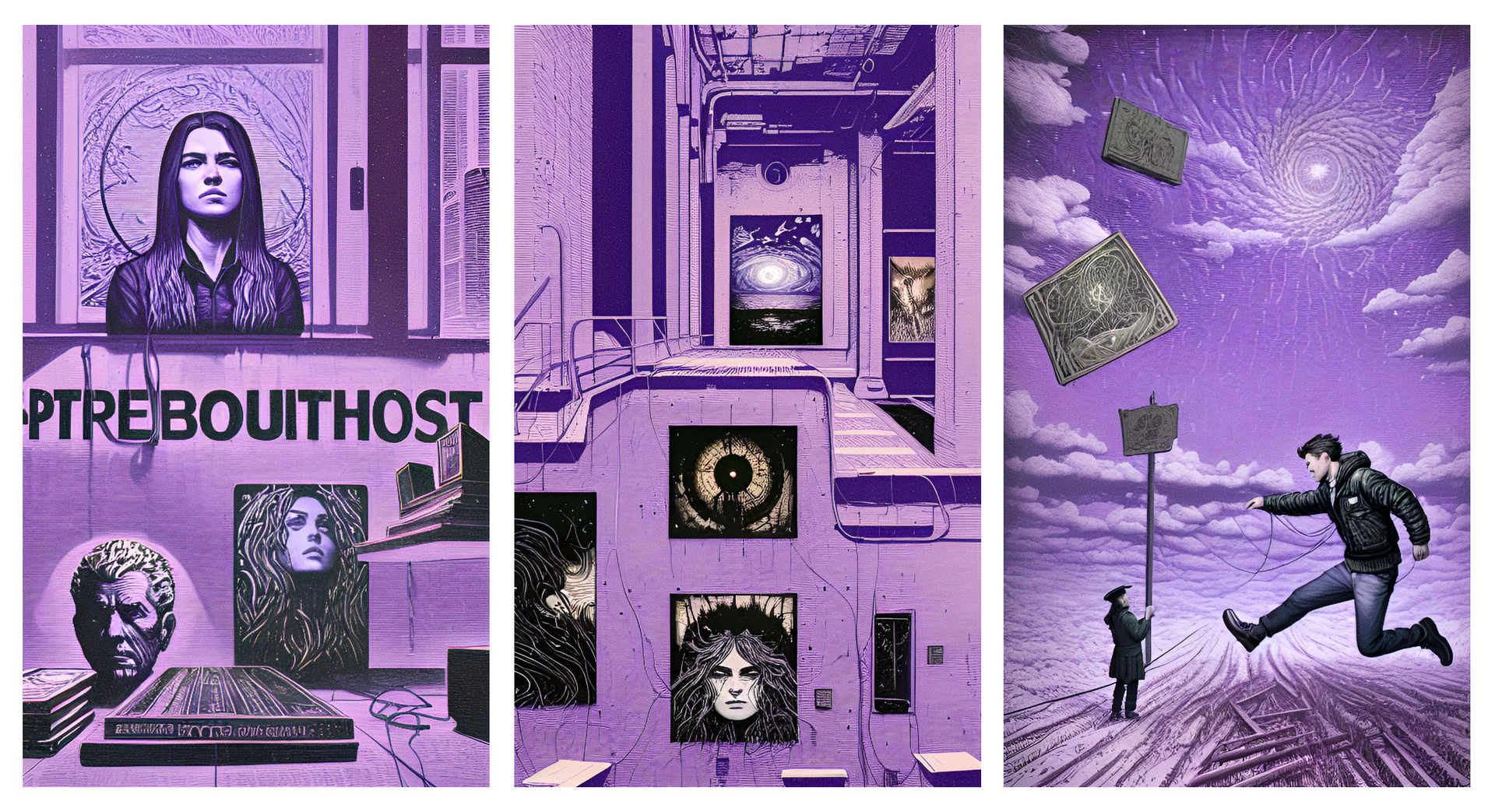
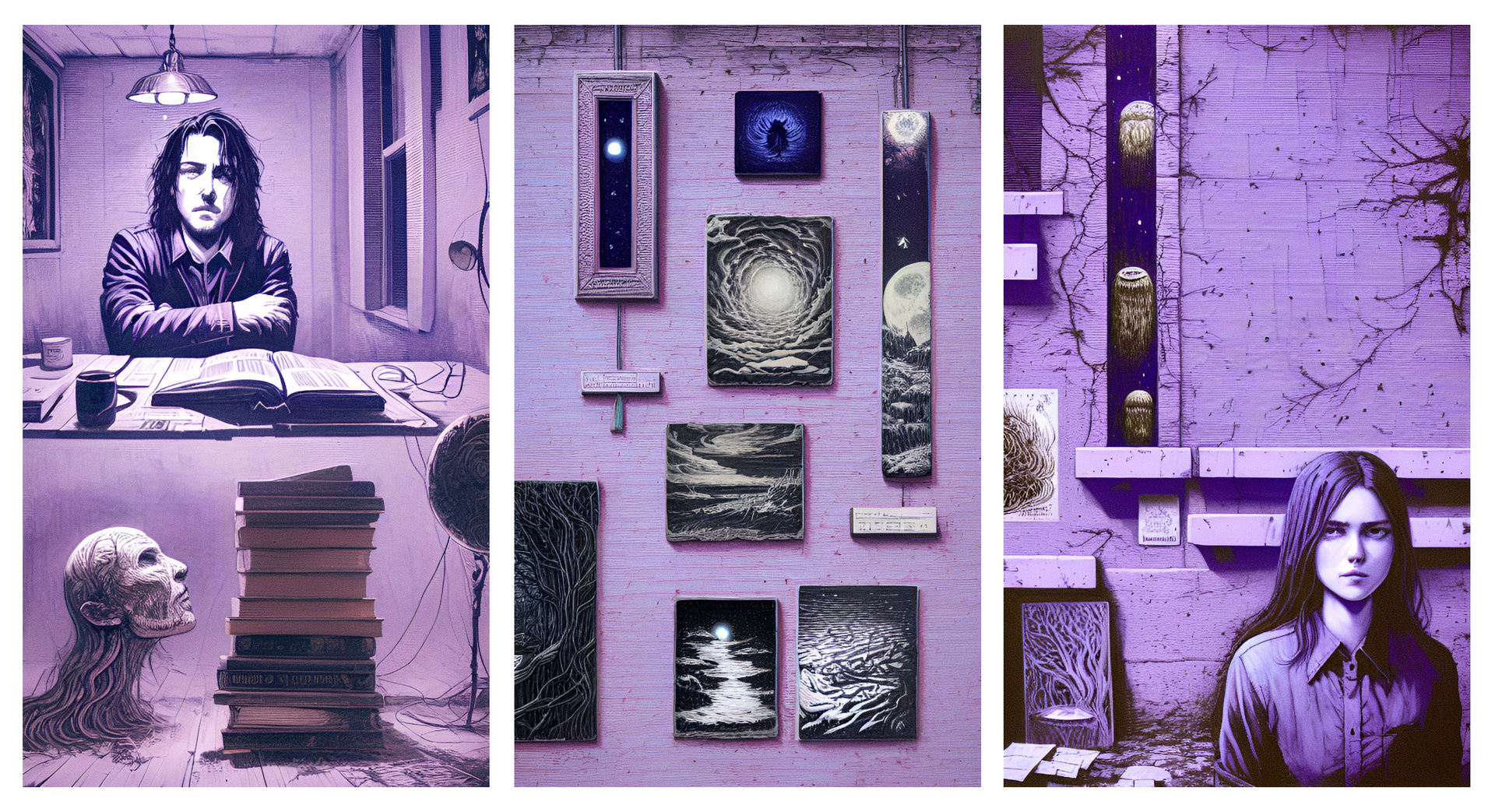
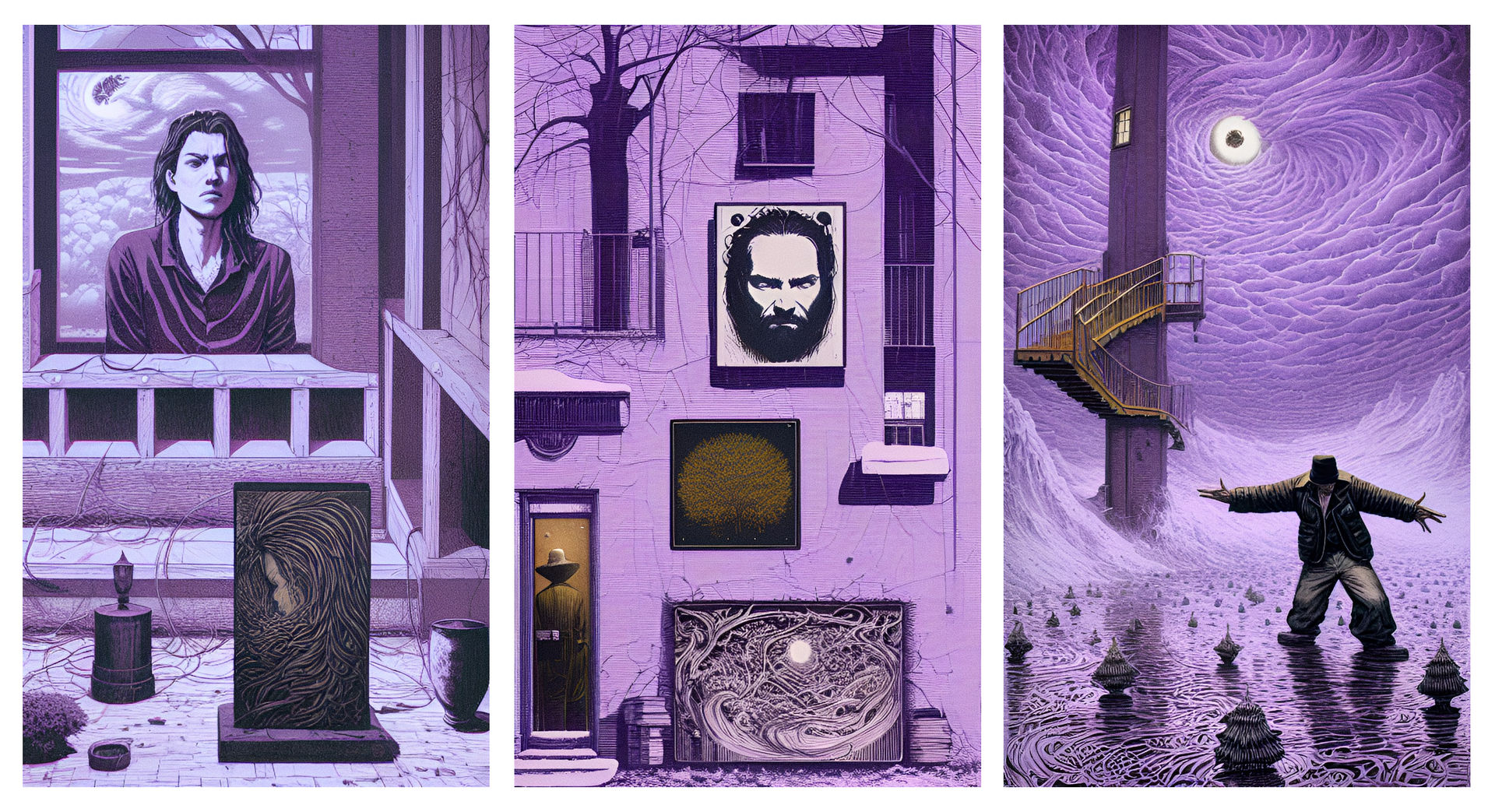
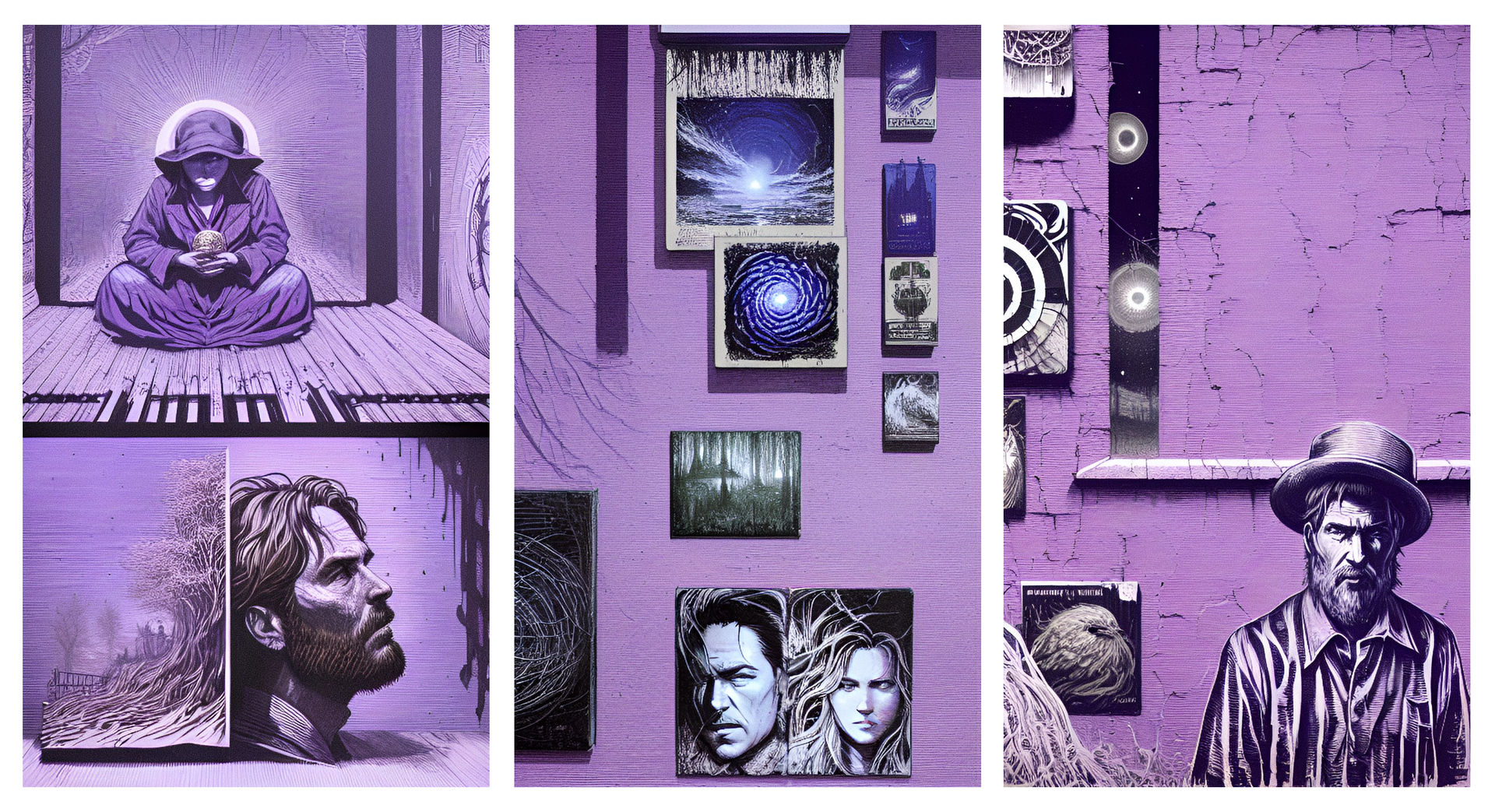
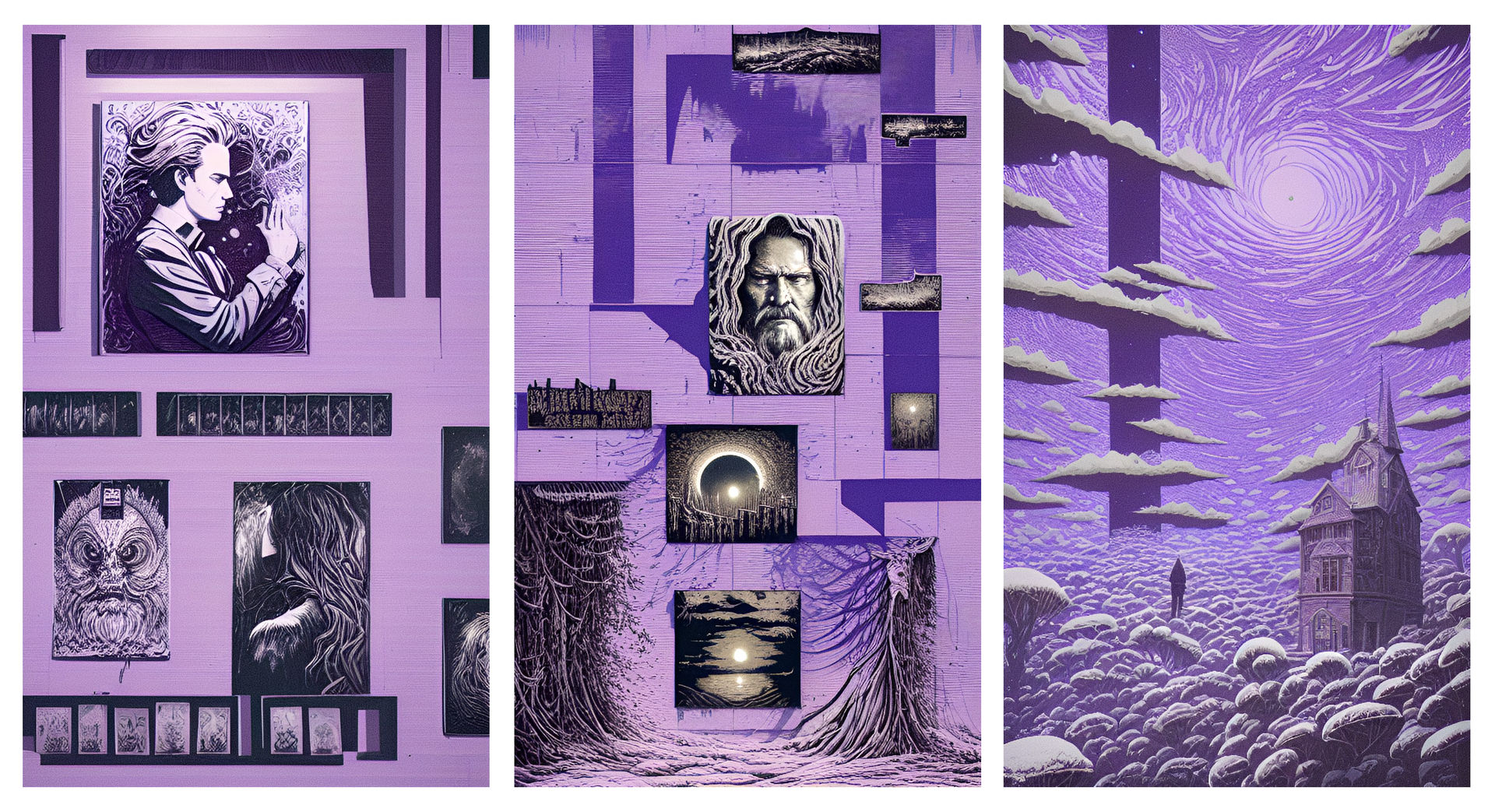
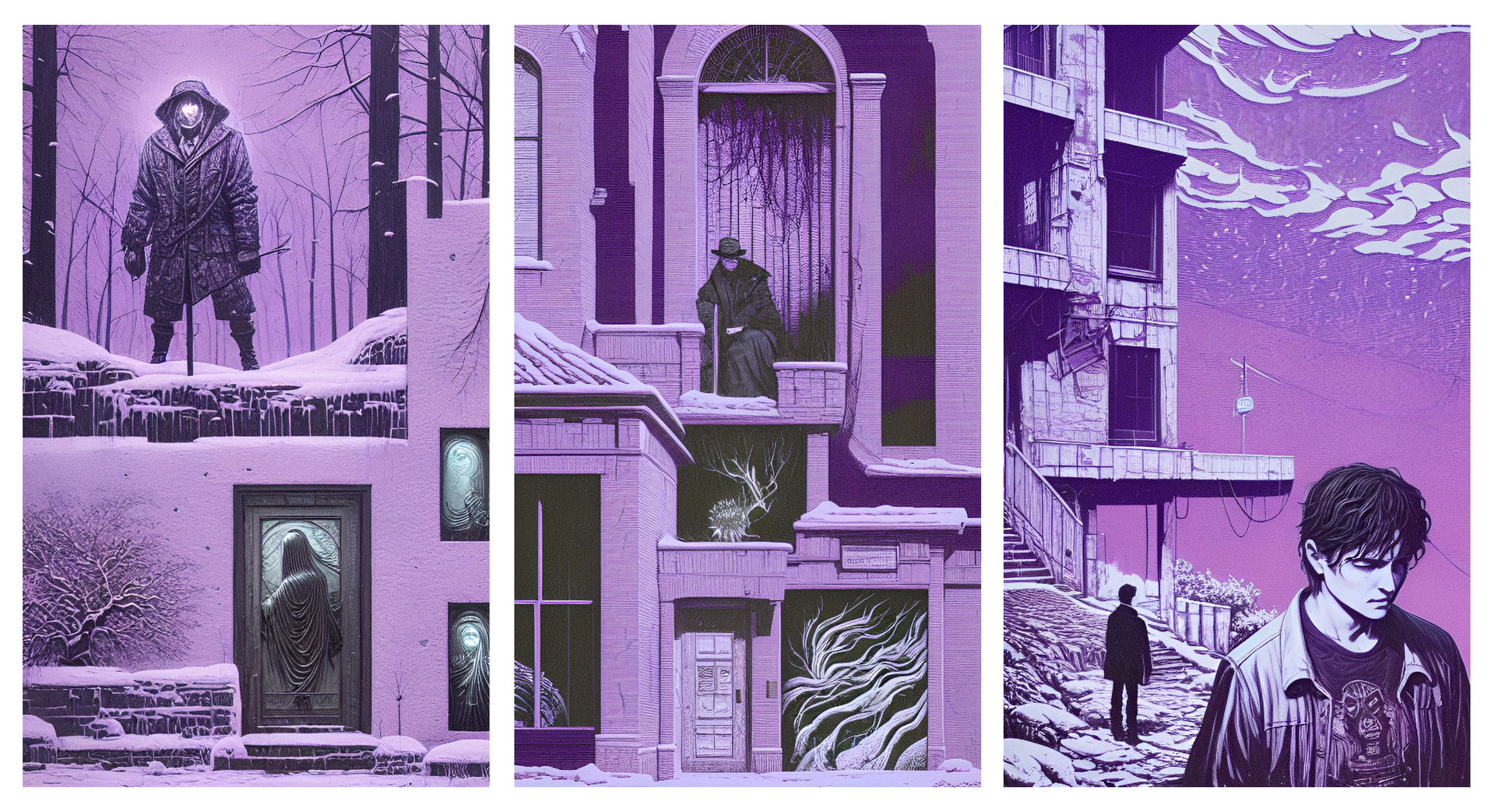
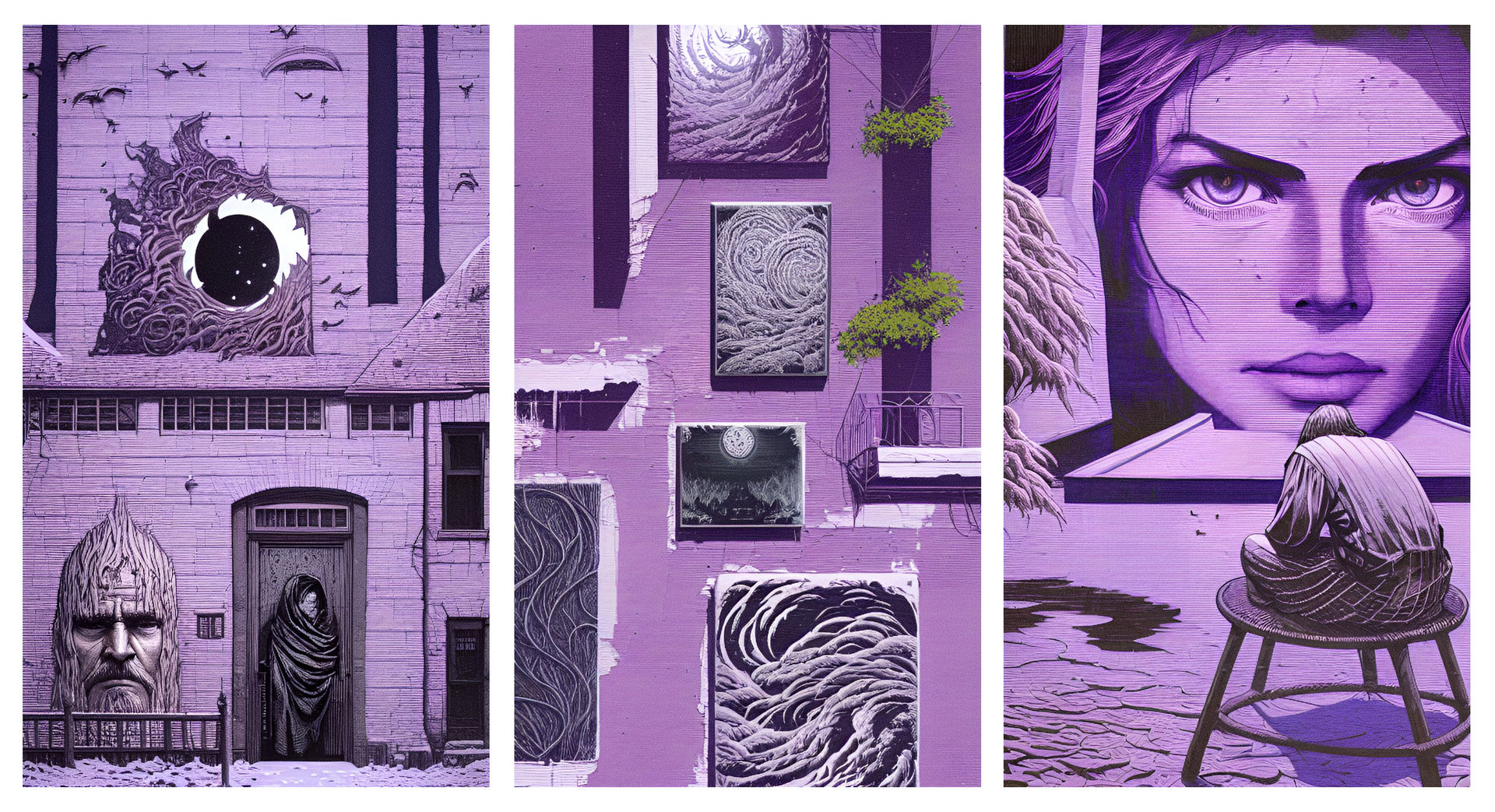
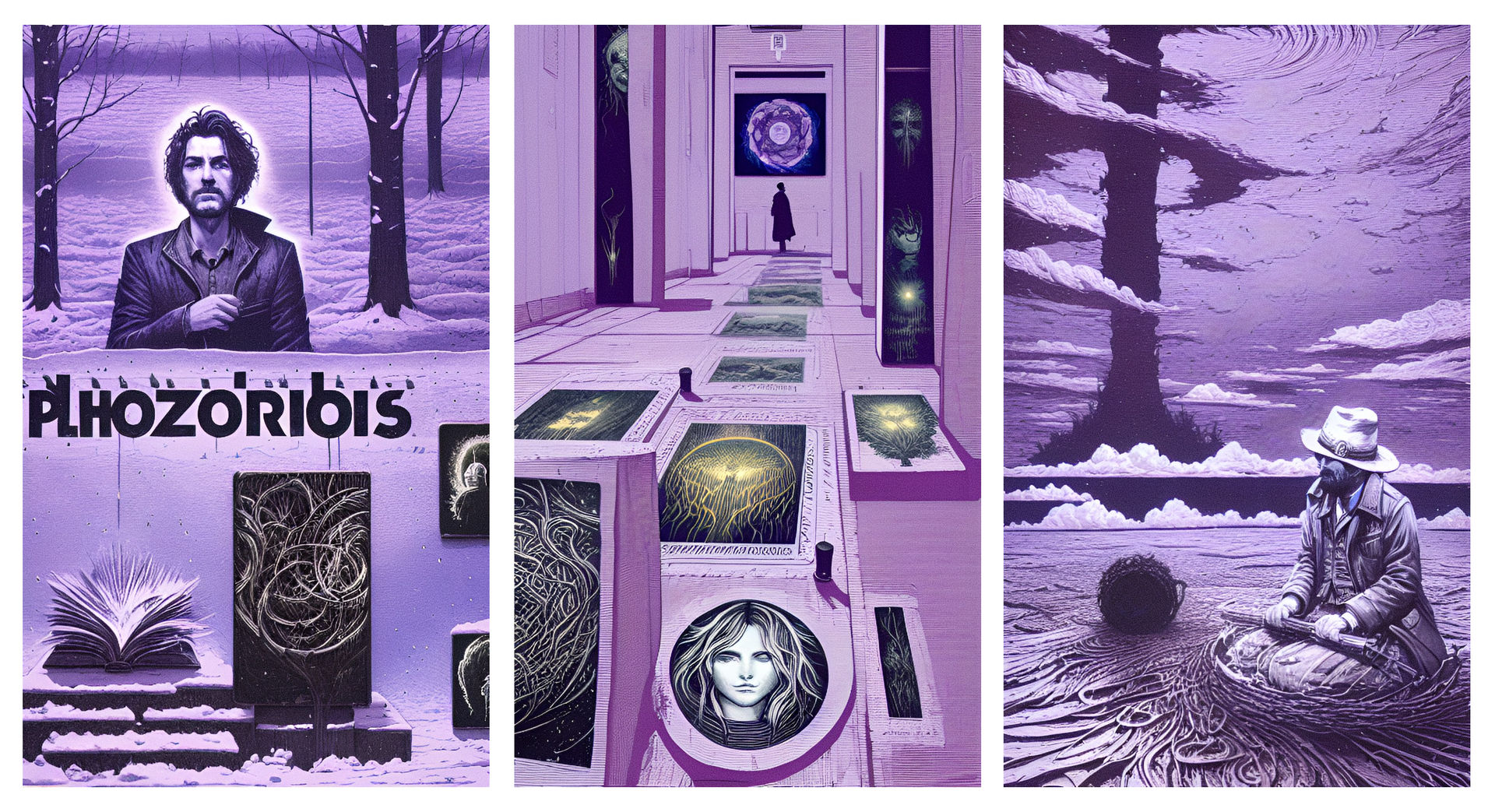
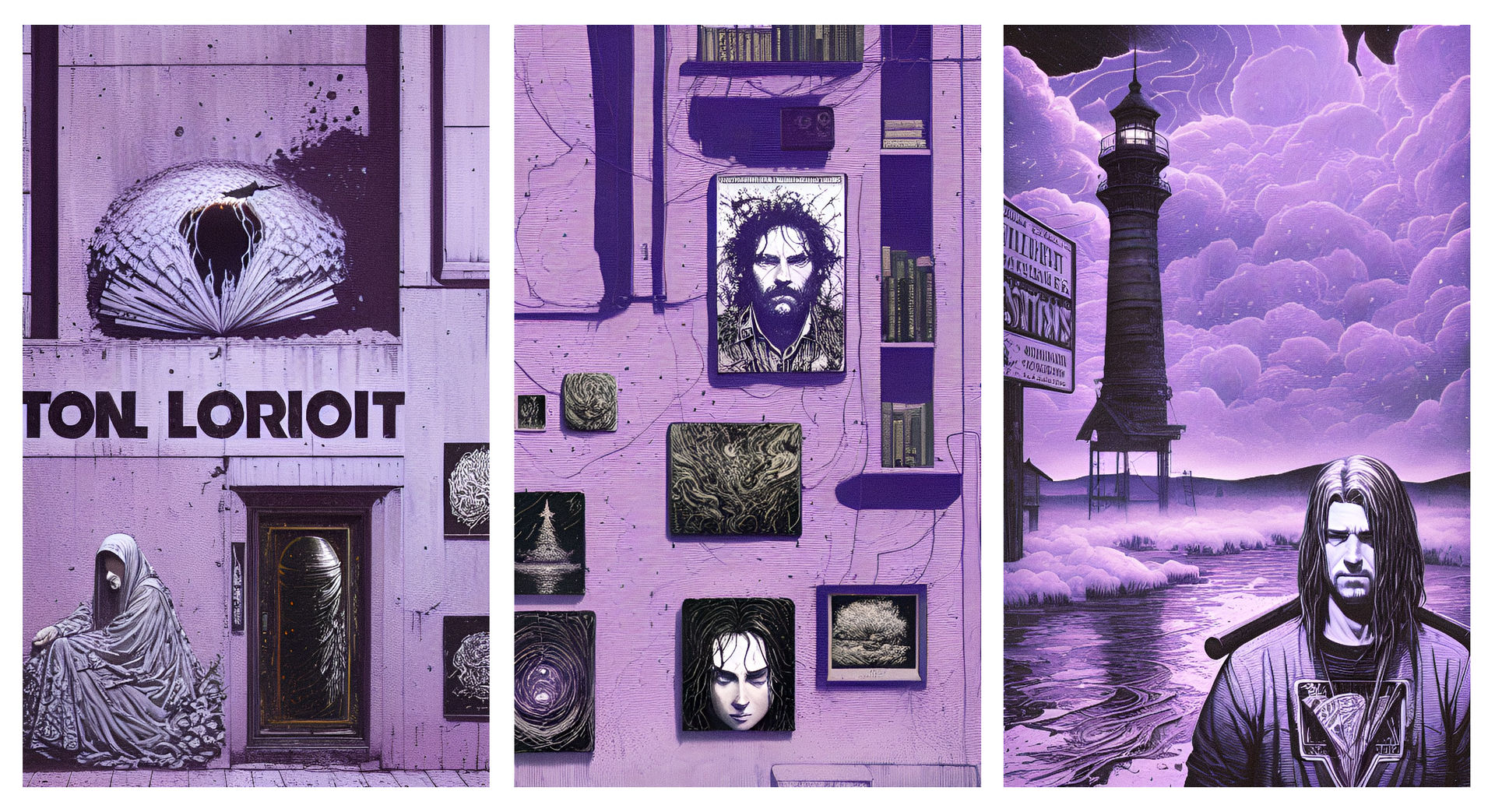
The original collage:

And ten AI triptychs I cobbled together, using the collage's title — Platitudes — as the prompt:










